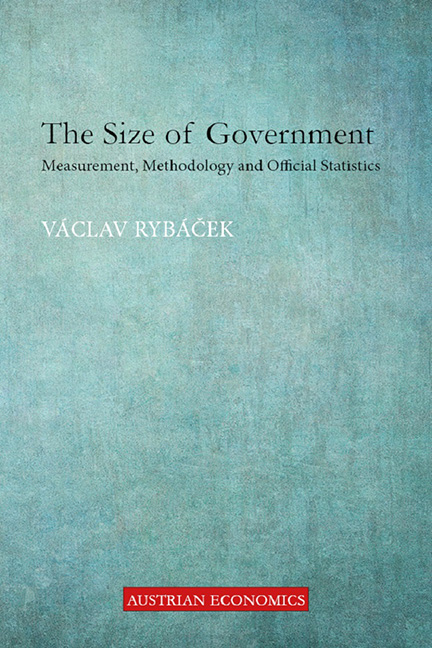Book contents
- Frontmatter
- Contents
- Introduction
- Chapter 1 The Size of Government in Economics
- Chapter 2 The Role of Measuring Government in Economic Policy
- Chapter 3 A Short Trip to the Past
- Chapter 4 The Current Approach
- Chapter 5 What’s Wrong with the Current Approach?
- Chapter 6 The Size of Government and GDP
- Chapter 7 Is the Size of Government Underestimated?
- Chapter 8 Recalculation of the Size of Government
- Conclusion
- Notes
- Bibliography
- Index
Chapter 8 - Recalculation of the Size of Government
Published online by Cambridge University Press: 09 August 2023
- Frontmatter
- Contents
- Introduction
- Chapter 1 The Size of Government in Economics
- Chapter 2 The Role of Measuring Government in Economic Policy
- Chapter 3 A Short Trip to the Past
- Chapter 4 The Current Approach
- Chapter 5 What’s Wrong with the Current Approach?
- Chapter 6 The Size of Government and GDP
- Chapter 7 Is the Size of Government Underestimated?
- Chapter 8 Recalculation of the Size of Government
- Conclusion
- Notes
- Bibliography
- Index
Summary
To crown our discussions in the previous chapters, we will now recalculate the size of the government sector in several alternative ways and compare these results with the official data. It will become apparent that the conventional measures are too narrowly defined. Consequently, if the methodological treatment of national accounts were changed, the findings of economic researchers would probably show different results on the relationship between government and other economic variables such as inflation, growth and unemployment.
Our analysis is, of course, limited by the current data availability. In spite of several data gaps, we have enough information to show that the officially presented figures constitute the lowest estimation of the size of government. Although our results are less favourable than those presented by national statistical offices, when it comes to redistribution or debt ratio, we believe that they provide a more realistic picture on both the size and the indebtedness of government.
Thus, we will use the aggregates recalculated in the previous chapter to present shares built on a different methodological approach. Of course, the way that relevant aggregates have been recalculated above might seem too radical, as well as the results. Nevertheless, as will be shown below, even conventionally quantified aggregates can be rearranged in a meaningful way, such that the size of government would be strikingly different than as officially presented. At the end of this chapter, we will also discuss the relation of statistics to relevant theoretical concepts.
GOVERNMENT EXPENDITURES RECALCULATED
Let’s start with the size of government in terms of total expenditures. Although the expenditures of public corporations are missing in our aggregates, we can still at least put the conventionally measured government sector into a different perspective by counting various government expenditures which are currently left out of macroeconomic models. Table 8.1 presents the results of the recalculation indicating the share between the recalculated government expenditure (see Table 7.2) and the recalculated GDP (see Table 6.5).
Table 8.1 illustrates the part of the recalculated GDP that is redistributed through the government accounts in the form of expenditure.
- Type
- Chapter
- Information
- The Size of GovernmentMeasurement, Methodology and Official Statistics, pp. 143 - 154Publisher: Agenda PublishingPrint publication year: 2019



